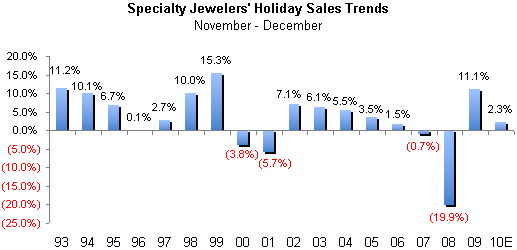IDEX Online Research: U.S. Holiday Jewelry Sales to Rise by Low-Single Digit
October 31, 10
(IDEX Online) - Jewelry sales during the all-important holiday selling season of November-December are projected to rise in a range of 2.5 percent to 3.0 percent in the U.S. market. For specialty jewelers, the sales increase will be slightly more modest: IDEX Online Research is forecasting a sales gain of 2.0 percent to 2.5 percent for the two-month holiday selling period.
The table below summarizes our forecast for the 2010 holiday selling period.
| Jewelry Market Segment | 2010 Holiday Sales Projection |
| Total U.S. Jewelry Market | +2.5% - 3.0% |
| Specialty Jewelers | +2.0% - 2.5% |
Holiday Jewelry Sales Expected to Show Modest Increase
This year’s holiday sales gain is expected to be well below last year’s double-digit increase. However, 2009’s sales increase was an aberration, since it reflected a comparison against 2008’s disastrous decline of over 13 percent.
The projected holiday sales gain for the U.S. jewelry industry of 2.5-3.0 percent for 2010, with a point estimate of 2.6 percent, is below the average holiday sales gain of 4.1 percent over the past two decades. The graph below summarizes holiday sales trends for the past two decades as well as our 2010 estimate.
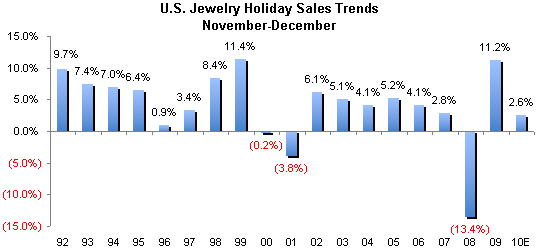
Source: US Dept of Commercce
There is a high correlation between jewelry demand and economic cyclicality. When the economy is growing, jewelry sales usually rise sharply. Conversely, when the economy is slowing, jewelry sales typically soften substantially.
While most forecasters are predicting that neither the U.S. economy nor other major global economies will slip into a double-dip recession, they are saying that the economic recovery that began in mid-2009 will be long and slow.
Earlier this year, the U.S. economy showed robust growth of 3.7 percent in the first quarter of 2010, but momentum slowed in the second quarter to +1.7 percent. Further, the Fed – which has been instrumental in orchestrating the recovery – continues to worry about the lack of vitality in the U.S. economy.
Because of the slowing economic momentum, jewelry demand has also slowed somewhat in recent months, after posting robust gains earlier in the year.
Three key economic factors continue to weigh on economic growth:
· Stubbornly high unemployment
· Lack of strong wage and salary growth
· Reduced personal debt levels and rising savings, both of which are good for consumers’ balance sheets, but neither of which promotes economic growth
Because of these trends in the consumer sector, businesses are not expanding at a pace which usually typifies a recovery cycle. Further, government spending is hindered by lack of tax revenues.
Jewelry Headwinds & Tailwinds
While it appears that the worst of the current recessionary environment is behind us, there are still headwinds and tailwinds affecting jewelry demand and retailers’ sales, as the following list illustrates:
Headwinds – Negative Factors
- The average jewelry ticket is down at retail. Thus, jewelers will need to sell more units of jewelry, just to reach last year’s sales level. Further, jewelers will need to raise their conversion rate – browser-to-buyer – if they expect to post a sales increase.
- The lack of consumer credit availability has dampened jewelry sales. Historically, up to half of all jewelry was sold on the monthly payment plan. The lack of credit has caused a typical mass market jeweler’s credit sales mix to fall to an estimated 40 percent for the industry in 2010.
- Conspicuous consumption remains temporarily out of favor; this has hurt luxury goods demand.
- The lack of new exciting jewelry has cut down on consumers’ frequency of shopping trips to local jewelers. Jewelry suppliers have been reluctant to introduce new goods, since jewelers’ showcases are full of last year’s merchandise. However, they fail to recognize that “newness” is the lifeblood of retailing, especially for fashion merchandise such as jewelry.
- Jewelry is no longer a “top-of-mind” luxury category due to the lack of a diamond industry marketing campaign. The planned launch of a consolidated promotional effort by diamond producers has been put on hold; this will hurt jewelry demand.
- Jewelers’ focus on price to exclusion of other factors has hurt merchant credibility and detracts from the “luxury” image of jewelry.
Tailwinds – Positive Factors
- Consumer traffic has increased in U.S. malls.
- Jewelers and other retail merchants are reporting an increased number of sales transactions.
- Most merchants are reporting an increased conversion rate – browsers-to-buyers – in their stores.
- Bridal jewelry demand remains strong.
- Demand is solid for unique jewelry, fashion jewelry, and custom jewelry.
- De Beers’ will promote sales with a generic diamond campaign that will be available for interested retailers too.
- There is no "hot" must-own consumer electronics gadget or other $200-$500 retail ticket item vying for consumers’ discretionary dollars this year. This will benefit jewelers in the 2010 holiday selling season of November and December.
- Merchants who typically emerge first from a recession are reporting stronger consumer demand. For example, the sale of men’s suits is up, as men need those suits for job interviews, and, more importantly, for new jobs.
Holiday Sales Gain Small Compared to Earlier Months in 2010
This year’s jewelry holiday sales forecast of +2.5-3.0 percent is much more modest than the year-to-date jewelry sales gain for the U.S. market of 7.8 percent. Why are sales gains expected to moderate in the November-December period?
The quick answer is this: it is a “trick of the math.” Monthly sales comparisons for the first eight months of 2010 were very easy, since sales were so weak in the first eight months of 2009. However, beginning in September 2009, monthly sales for jewelry turned positive, when compared to the prior year. Further, they continued to strengthen for the remaining months of 2009. Thus, comparisons in the final four months of 2010 are against relatively strong sales in the prior year. As a result, percentage gains are much smaller, even though the sales momentum remains solid.
The graph below illustrates monthly jewelry sales trends for the past 18 months.
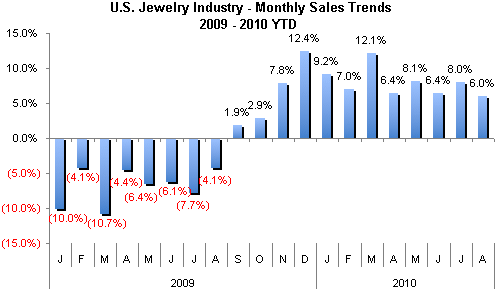
Source: US Dept of Commercce
Further, because of the mathematical aberration, we expect full year jewelry sales in the U.S. market to be up by just over 5 percent versus 2009, a slower pace than the first eight months of the year.
Holiday Sales Smaller Portion of Annual Sales
As recently as the 1990s, specialty jewelers generated up to 35 percent of their annual sales during the all-important November-December period. However, over the past decade, holiday sales have been on a slow decline as a portion of a jewelry merchant’s annual sales.
During the disastrous holiday selling period of 2008, holiday sales sank to just over 25 percent of a typical specialty jeweler’s yearly sales. Holiday sales recovered somewhat last year – 2009 – to 29.5 percent of total annual sales. However, based on our forecast this year, the typical specialty jeweler’s November-December sales could represent just less than 29 percent of their total year’s sales, as the graph below illustrates.
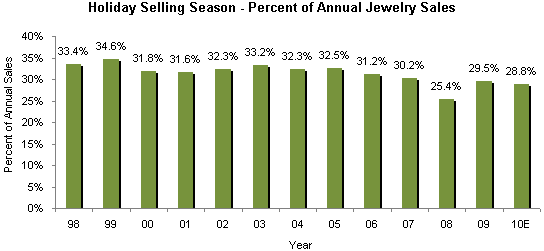
Source: US Dept of Commercce
Why is this trend troubling? Jewelers have traditionally waited for the holiday period to make virtually all of their annual profits – it has truly been a “make-it-or-break-it” season. In this post-recession period, jewelers must find ways to build sales and generate profits in all four quarters, if they are to remain in business.
Specialty Jewelers’ Sales Gains to Be More Modest
Specialty jewelers in the U.S. market are expected to post a more modest sales gain during the all-important holiday selling season. For the past four decades, specialty jewelers have been losing market share to other retailers – mostly multi-line merchants. The loss of market share tends to accelerate during recessions, since consumers seek jewelry from discounters and other merchants who appear to offer the perception of value-pricing.
For almost every month this year, jewelry sales gains at multi-line merchants have grown faster than jewelry sales at specialty retailers, as the graph below illustrates. Specialty jewelers’ sales trends are shown by the blue bars, while jewelry sales by other merchants are shown by the red bars.
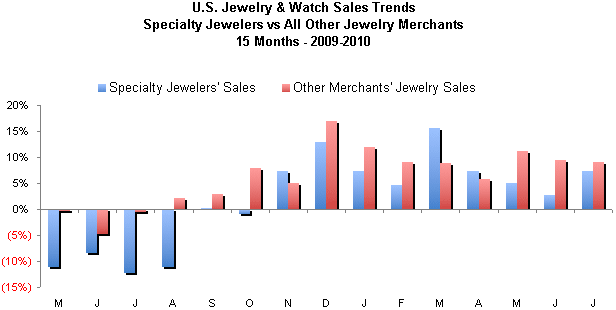
Source: US Dept of Commercce
Our holiday sales forecast for specialty jewelers in t he U.S. market calls for a sales gain of 2.0 percent to 2.5 percent, as the following graph illustrates. This is well below the average of a 3.6 percent sales gain over the past two decades.
|
|
Holiday Jewelry Sales Likely to Outpace Other Retail Categories
Consensus forecasts for U.S. retail sales call for gains in the low single-digit range. The National Retail Federation, which typically is a bit more optimistic than other forecasters, is calling for a retail sales gain of 2.3 percent. We believe that jewelry sales will slightly outpace total retail sales. This has been the trend so far in the economic recovery, as the graph below illustrates.
Jewelry sales (red bars) has been much stronger than demand for most other retail categories (green bars).
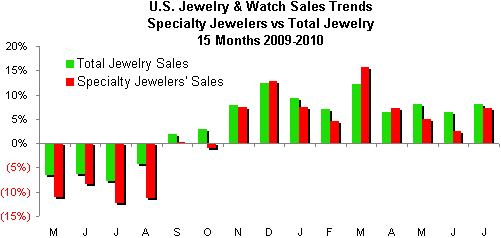
Source: US Dept of Commercce
